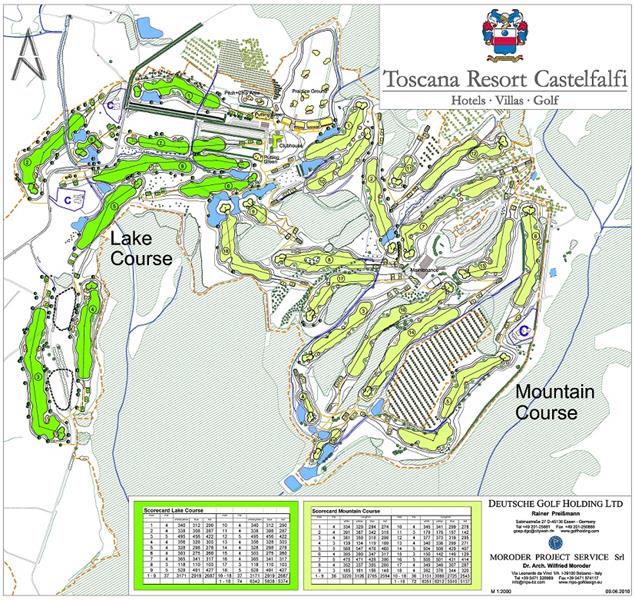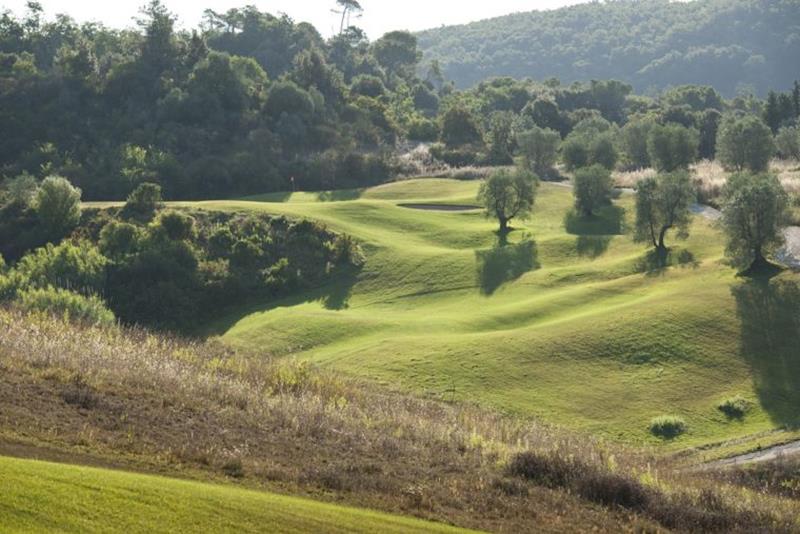With the opening of the 5* TUI Blue Selection Hotel Il Castelfalfi, an important step was done to show why this area of Tuscany in Italy will be more than attractive for golf enthusiasts and other tourists.
South of Pisa, in the heart of Tuscany, a new 27 hole Golf Complex has been built in 2009. The golf courses belong to a 1.100 hectares large property, called Tenuta di Castelfalfi, which includes an ancient Borgo (Village on a Hill) with a Castello, which dates back to the Middle Ages.
The Tenuta was original agricultural farm- and woodland in combination with Vineyards and an abundance of Olive trees surrounding the area.
The golf courses are in the center point of the resort, originally planned as two 18 hole courses in combination with a comfortable Practice Area.
The contract for the design and artistically design construction inspection was given to Rainer Preißmann and Maximilian Frhr. von Wendt with their respective design team Deutsche Golf Holding Ltd in Essen, Germany.
They worked in cooperation with Dr. Arch. Wilfried Moroder from MPS – Golf Design in Bolzano, Italy, who guided the project through the sensitive permission stages.
The Golf Project, in general, was developed by the Senior Golf Course Architect Rainer Preißmann in a Masterplan procedure and together with Wilfried Moroder the golf project was integrated into the natural landscape and harmonized with the other urban and building projects of the resort.

The design work included the renovation and remodeling of an existing golf course, originally designed by Sen. Mancinelli some 20 years ago, which was neglected over the last decades.
With respect to the beautiful landscape features, the existing golf course was completely re-designed and elevated to a modern and more strategical standard.
Blind holes and steep inclines have been totally eliminated and the new holes have been completely re-designed and integrated into the existing typical landscape of Tuscany.
The planning process – Toscana Resort Castelfalfi
The planning process in total was based on sustainable golf development guidelines of the European Institute of Golf Course Architects (EIGCA) and the office own philosophy to respect and enrich the character and aesthetic qualities of a landscape as well as the environmental conditions.
The growth for centuries in harmony between man and nature, respect natural environment and traditional agricultural is a myth and an obligation at the same time in Tuscany.
That clarifies the fact that the principles of sustainability aren’t a political phrase only but a tradition in that region.
The diversity of the landscape, including the avenues of Cypresses, a relic of the Etruscan and Roman land surveying, have been combined with the golf course elements in a manner that the golfer and other users of this area get the impression that there is a grown cultural landscape where randomly some fairways invite to play golf.
The attached map shows (see picture above) the position of the 18 hole Mountain Course, the first nine holes of the Lake Course and the Practice Ground as well as the position of the Clubhouse and the Maintenance Station.
The Clubhouse position in a strategically ideal location at the foot of the Borgo and the Castello allow organizing four loops of 9 holes as well as the nearby practice ground.
From here the golfer has a fascinating view over the lakes in the valley, where the greens of the four finishing holes of the two courses are located.

The golf courses – Toscana Resort Castelfalfi
The more challenging Mountain Course is the flagship course which allows it to be prepared for national and international competitions.
Both nine holes of the Mountain Course start and end south of the Clubhouse. They have both been designed in a way that the golfers can enjoy the impressive landscape on both 9 holes.
The routing through the Tuscany hills and the integration into the local landscape as well as the design and careful placement of the hazards, together with an attractive variation of the length and the position and direction of each hole, provides an individual character which will be very memorable for all visiting golfers.
A good example of this is the 18th, which has to be played downhill to a half-island green with an impressive view up to the Borgo.
But the signature hole will certainly be the 9th hole, a Par 3 played downhill having a 40 m level difference between tee and green and is something you rarely find on other top Golf courses.
After a one year’s construction and grow in the period the Mountain Course and the Practice Ground was opened the 28. August 2010.
The first nine holes of the Lake Course, which will be more of a Resort Course, were opened in September 2011.
The holes of the Lake Course run in long loops through the landscape southwest of the Clubhouse, which has been carefully designed into the typical Tuscany cultural landscape with its gentle hilly character.
Each hole has its own character and individual approach.
The north facing Driving Range complex has individual target greens and has been perfectly designed and located opposite the Clubhouse area.
The Driving Range is situated in an impressive valley with an abundance of olive trees and scenic woodland areas. The practice area consists of covered and open tee boxes which are integrated into the Golf Academy building.
Adjacent to the starting holes of the two courses are putting greens and also practice areas for ones short-game.

Sustainability aspects of irrigation – Toscana Resort Castelfalfi
The climatic situation shows hot summer with low rainfall and a season from October until May when heavy rainfall is possible.
On the background that the usage of groundwater and potable water wasn’t allowed we had to organize an intelligent system to collect water during the times with heavy rainfalls for the dry period.
So an important task was to optimize the ability to collect, storage and re-use surface run-off and other water supply.
On the golf courses, the water features are the backbone of the sustainable handling of the water resources. The absolute abdication of the usage of groundwater and potable water was possible through a system of retention areas.
In these areas, water has to be collected during heavy rainfall times and transported with the assistance of three pump station to the so-called “Borgo Lake” with a capacity of 350.000m³.
The Borgo Lake is used as a reservoir for the collection of surface water, recycled water through purification from the treatment plant of the resort and process water from the vine and olive oil production of the Tenuta di Castelfalfi.
From there the water will be applied to the irrigation system of the complete resort including the golf courses.
To collect the surface water runoff which could be used for storing a low and high water level was fixed for all water bodies on the golf courses.
With a difference of one meter only between this both levels it is possible to store around 25.000 m³ water in the lakes of the golf courses and additional 35.000m³ in adjacent ponds and lakes – if necessary.
Three pump stations have been integrated into the dykes of the last lakes of the system.
To make sure that there is enough remaining water for the natural water courses downriver the golf courses during low water seasons it was necessary to create a technical close and runoff system and an overflow for times with too much rainfall.
In this case, the water runs over a stone package on top of the dyke.
To support the reduction of the water usage irrigation was concentrated on tees, greens, fairways and semi-rough only.
Additionally, grass species with lower water consumption like Festuca arundinacaea have been chosen for fairways and semi-rough.
This species have lower demand for the water supply and are able to use remaining water from deeper areas through their deep growing roots.
In the playable rough area, we used Festuca rubra rubra and Festuca ovina which gives a nice colour in summer and later, combined with local grass species and flowers in the outer roughs. In these areas, no irrigation is needed.
Conclusion
In total, this project is a very helpful example to show how golf courses and the existing landscape could fit together and how irrigation could be possible without using groundwater and potable water.
The Mountain Course was 2011 honoured by the Golf Inc. magazine with the third place in the category Renovation of the Year “Private – Over $1 million”.
